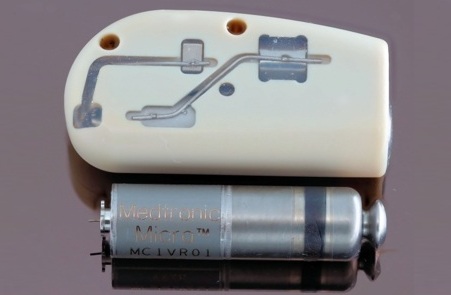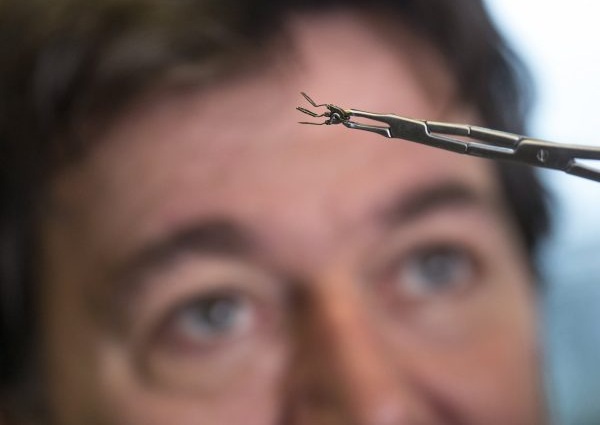Miniaturized Pacemaker for Newborns Found Safe and Effective for Up to Two Years
|
By HospiMedica International staff writers Posted on 05 Mar 2025 |

Pacemakers are implantable devices powered by batteries that regulate the heart's rhythm by producing electrical impulses. Traditional pacemakers consist of a generator, wires (leads), and electrodes, which work to control irregular heartbeats. However, these devices are designed for adults, creating difficulties when implanted in small children, who make up approximately 1% of pacemaker recipients. The first issue is that traditional pacemakers are too large for infants, particularly newborns or preterm babies. The second challenge arises from the fact that in adults and older children, the pacemaker wires are typically threaded through veins, but for infants, an open-chest approach is required to directly attach the wire to the heart. Now, a newly developed pediatric pacemaker could provide a better solution for newborns, offering an alternative to the adult-sized devices currently used, which can pose health risks for these young patients. While no pacemakers for infants are yet approved in the U.S., new research published in Circulation: Arrhythmia and Electrophysiology confirms that this miniaturized pacemaker is both safe and effective for up to two years.
Infants may need pacemakers if they are born with congenital heart block, a rare condition where electrical signals do not travel properly through the heart, leading to a slow heart rate. Pacemakers may also be necessary for babies with other rare congenital heart defects. Very small infants often cannot receive permanent pacemakers and instead require multiple temporary pacing wires or other methods until they grow large enough for traditional pacemaker placement. The study conducted by researchers at Children’s National Hospital (Washington, D.C., USg) tested a pacemaker specifically modified for infants, showing it safely and effectively stabilized heart rhythms for up to two years. This research addresses a critical need, potentially reducing hospital stays for affected infants.
The pediatric pacemaker tested is about one-quarter the size of traditional pacemakers, smaller than an AAA battery. Researchers evaluated the device at 12 pediatric hospitals across the U.S., involving 29 newborns and infants who received the miniature pacemaker. The babies in the study had a median age of 15 days and a median weight of approximately 5 pounds, with many being born prematurely. Some also had congenital heart defects. The devices were successfully implanted, and their stability was confirmed for an average of 325 days, with the longest period being 2.2 years. This smaller pacemaker presents a viable alternative to conventional pacemakers for newborns and could eventually be used for a larger pool of pacemaker patients. Furthermore, it may also be a beneficial option for frail elderly individuals and could serve as a better alternative for certain children and adults.
“The need for an urgent permanent pacemaker in newborns is quite rare, but when needed, it is often an emergency,” said study lead author Charles I. Berul, M.D., a pediatric electrophysiologist at Children's National Hospital. “We are working on a small port that would deliver this pacemaker through a straw-sized tool instead of requiring open chest surgery. This port has been tested in the lab and in small animals.”
Latest Critical Care News
- AI Model Analyzes Patient Data to Diagnose Multiple Sclerosis With 90% Accuracy
- Magnetically Navigable Microparticles Enable Targeted Drug Delivery
- AI-Powered Algorithm Automates Analysis of Coronary Stents After Implantation
- New Stroke Risk Scoring System to Help Avoid Unnecessary Surgeries
- Wearable Device Tracks Individual Cells in Bloodstream in Real Time
- Drug Delivery System Uses Ultrasound-Activated Nanoparticles to Destroy Bacterial Biofilms
- New Potent Injectable Therapy Could Prevent Heart Failure After Heart Attack
- Hospital-Based System Combines AI and Genomic Surveillance to Quickly Detect Infectious Disease Outbreaks
- New Approach to Visualizing Blood Pressure Data Can Help Better Manage Hypertension Patients
- Breakthrough AI Technology Accurately Assesses Heart Failure Severity
- Smart Bandage Monitors Chronic Wounds in Human Patients
- AI Identifies Patients with Increased Lung Cancer Risk Up To 4 Months Earlier
- Next Gen Hemodynamic Monitoring Solution Provides AI-Driven Clinical Decision Support
- AI Algorithm Identifies High-Risk Heart Patients
- Wearable Glucose Monitor Offers Less Invasive Approach to Assessing Diabetes Risk
- Wireless, Self-Powered Smart Insole to Improve Personal Health Monitoring
Channels
Surgical Techniques
view channel
DNA Origami Improves Imaging of Dense Pancreatic Tissue for Cancer Detection and Treatment
One of the challenges of fighting pancreatic cancer is finding ways to penetrate the organ’s dense tissue to define the margins between malignant and normal tissue. Now, a new study uses DNA origami structures... Read more
Pioneering Sutureless Coronary Bypass Technology to Eliminate Open-Chest Procedures
In patients with coronary artery disease, certain blood vessels may be narrowed or blocked, requiring a stent or a bypass (also known as diversion) to restore blood flow to the heart. Bypass surgeries... Read more
Intravascular Imaging for Guiding Stent Implantation Ensures Safer Stenting Procedures
Patients diagnosed with coronary artery disease, which is caused by plaque accumulation within the arteries leading to chest pain, shortness of breath, and potential heart attacks, frequently undergo percutaneous... Read more
World's First AI Surgical Guidance Platform Allows Surgeons to Measure Success in Real-Time
Surgeons have always faced challenges in measuring their progress toward surgical goals during procedures. Traditionally, obtaining measurements required stepping out of the sterile environment to perform... Read morePatient Care
view channel
Portable Biosensor Platform to Reduce Hospital-Acquired Infections
Approximately 4 million patients in the European Union acquire healthcare-associated infections (HAIs) or nosocomial infections each year, with around 37,000 deaths directly resulting from these infections,... Read moreFirst-Of-Its-Kind Portable Germicidal Light Technology Disinfects High-Touch Clinical Surfaces in Seconds
Reducing healthcare-acquired infections (HAIs) remains a pressing issue within global healthcare systems. In the United States alone, 1.7 million patients contract HAIs annually, leading to approximately... Read more
Surgical Capacity Optimization Solution Helps Hospitals Boost OR Utilization
An innovative solution has the capability to transform surgical capacity utilization by targeting the root cause of surgical block time inefficiencies. Fujitsu Limited’s (Tokyo, Japan) Surgical Capacity... Read more
Game-Changing Innovation in Surgical Instrument Sterilization Significantly Improves OR Throughput
A groundbreaking innovation enables hospitals to significantly improve instrument processing time and throughput in operating rooms (ORs) and sterile processing departments. Turbett Surgical, Inc.... Read moreHealth IT
view channel
Printable Molecule-Selective Nanoparticles Enable Mass Production of Wearable Biosensors
The future of medicine is likely to focus on the personalization of healthcare—understanding exactly what an individual requires and delivering the appropriate combination of nutrients, metabolites, and... Read more
Smartwatches Could Detect Congestive Heart Failure
Diagnosing congestive heart failure (CHF) typically requires expensive and time-consuming imaging techniques like echocardiography, also known as cardiac ultrasound. Previously, detecting CHF by analyzing... Read moreBusiness
view channel
Expanded Collaboration to Transform OR Technology Through AI and Automation
The expansion of an existing collaboration between three leading companies aims to develop artificial intelligence (AI)-driven solutions for smart operating rooms with sophisticated monitoring and automation.... Read more















